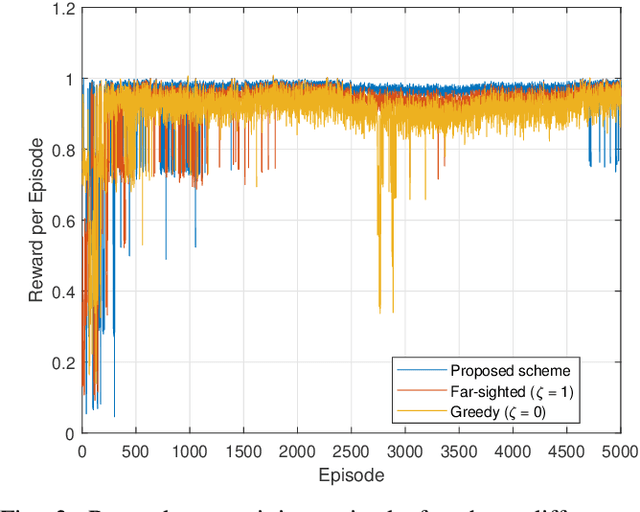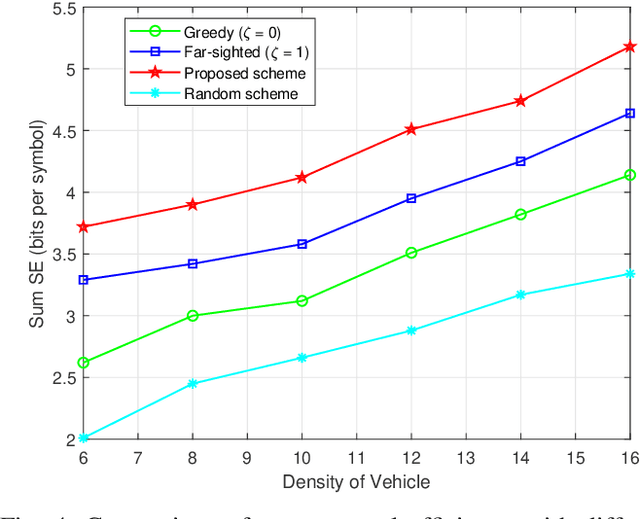Leila Musavian
DMA-aided MU-MISO Systems for Power Splitting SWIPT via Lorentzian-Constrained Holography
Nov 11, 2025Abstract:This paper presents an optimal power splitting and beamforming design for co-located simultaneous wireless information and power transfer (SWIPT) users in Dynamic Metasurface Antenna (DMA)-aided multiuser multiple-input single-output (MISO) systems. The objective is to minimize transmit power while meeting users signal-to-interference-plus-noise ratio (SINR) and energy harvesting (EH) requirements. The problem is solved via an alternating optimization framework based on semidefinite programming (SDP), where metasurface tunability follows Lorentzian-constrained holography (LCH). In contrast to traditional beamforming architectures, DMA-assisted architectures reduce the need for RF chains and phase shifters but require optimization under the Lorentzian constraint limiting the amplitude and phase optimizations. Hence, the proposed method integrates several LCH schemes, including the recently proposed adaptive-radius LCH (ARLCH), and evaluates nonlinear EH models and circuit noise effects. Simulation results show that the proposed design significantly reduces transmit power compared with baseline methods, highlighting the efficiency of ARLCH and optimal power splitting in DMA-assisted SWIPT systems.
Non-Orthogonal AFDM: A Promising Spectrum-Efficient Waveform for 6G High-Mobility Communications
Jul 23, 2025Abstract:This paper proposes a spectrum-efficient nonorthogonal affine frequency division multiplexing (AFDM) waveform for reliable high-mobility communications in the upcoming sixth-generation (6G) mobile systems. Our core idea is to introduce a compression factor to enable controllable subcarrier overlapping in chirp-based AFDM modulation. To mitigate intercarrier interference (ICI), we introduce linear precoding at the transmitter and an iterative detection scheme at the receiver. Simulation results demonstrate that these techniques can effectively reduce interference and maintain robust bit error rate (BER) performance even under aggressive compression factors and high-mobility channel conditions. The proposed non-orthogonal AFDM waveform offers a promising solution for next-generation wireless networks, balancing spectrum efficiency and Doppler resilience in highly dynamic environments.
Semantic Communications in 6G: Coexistence, Multiple Access, and Satellite Networks
Jun 13, 2025Abstract:The exponential growth of wireless users and bandwidth constraints necessitates innovative communication paradigms for next-generation networks. Semantic Communication (SemCom) emerges as a promising solution by transmitting extracted meaning rather than raw bits, enhancing spectral efficiency and enabling intelligent resource allocation. This paper explores the integration of SemCom with conventional Bit-based Communication (BitCom) in heterogeneous networks, highlighting key challenges and opportunities. We analyze multiple access techniques, including Non-Orthogonal Multiple Access (NOMA), to support coexisting SemCom and BitCom users. Furthermore, we examine multi-modal SemCom frameworks for handling diverse data types and discuss their applications in satellite networks, where semantic techniques mitigate bandwidth limitations and harsh channel conditions. Finally, we identify future directions for deploying semantic-aware systems in 6G and beyond.
Lorentzian-Constrained Holographic Beamforming Optimization in Multi-user Networks with Dynamic Metasurface Antennas
May 13, 2025Abstract:Dynamic metasurface antennas (DMAs) are promising alternatives to fully digital (FD) architectures, enabling hybrid beamforming via low-cost reconfigurable metasurfaces. In DMAs, holographic beamforming is achieved through tunable elements by Lorentzian-constrained holography (LCH), significantly reducing the need for radio-frequency (RF) chains and analog circuitry. However, the Lorentzian constraints and limited RF chains introduce a trade-off between reduced system complexity and beamforming performance, especially in dense network scenarios. This paper addresses resource allocation in multi-user multiple-input-single-output (MISO) networks under the Signal-to-Interference-plus-Noise Ratio (SINR) constraints, aiming to minimize total transmit power. We propose a holographic beamforming algorithm based on the Generalized Method of Lorentzian-Constrained Holography (GMLCH), which optimizes DMA weights, yielding flexibility for using various LCH techniques to tackle the aforementioned trade-offs. Building upon GMLCH, we further propose a new algorithm, Adaptive Radius Lorentzian Constrained Holography (ARLCH), which achieves optimization of DMA weights with additional degree of freedom in a greater optimization space, and provides lower transmitted power, while improving scalability for higher number of users. Numerical results show that ARLCH reduces power consumption by over 20% compared to benchmarks, with increasing effectiveness as the number of users grows.
Hybrid NOMA Assisted Heterogeneous Semantic and Bit Users Communication
May 06, 2025Abstract:In this paper, we utilize a downlink hybrid Non-Orthogonal Multiple Access (NOMA) framework to support multiple semantic and bit users within the communication network. The hybrid NOMA setup exploits both NOMA and Orthogonal Multiple Access (OMA) which has the benefit of enhancing Spectral Efficiency (SE) by allowing users to dynamically access the resources in multiple heterogeneous slots. This enables integrating semantic and bit users based on their channel gains, while adopting bit-to-semantic decoding order in slots including heterogeneous users. An optimization problem for the power allocation is formulated with the aim of maximizing the equivalent ergodic semantic SE with a constraint on the total available power of the Access Point (AP). The proposed algorithm uses NOMA in shared slots and OMA in bit-user-only slots. Simulation results validate the benefits of heterogeneous users hybrid NOMA setup in comparison to OMA-only for heterogeneous users.
Generalized Spatial Modulation Aided Affine Frequency Division Multiplexing
Jan 18, 2025Abstract:Generalized spatial modulation-aided affine frequency division multiplexing (GSM-AFDM) is conceived for reliable multiple-input multiple-output (MIMO) communications over doubly selective channels. We commence by proposing several low-complexity detectors for large-scale GSM-AFDM systems. Specifically, we introduce the linear minimum mean square error (LMMSE) equalizer-based maximum likelihood detector (LMMSE-MLD). By exploiting the GSM properties, we then derive the LMMSE-based transmit-antenna activation pattern (TAP) check-based log-likelihood ratio detector (LMMSE-TC-LLRD). In addition, we propose a pair of new detectors, namely the greedy residual check detector (GRCD) and the reduced space check detector (RSCD). We also derive a bit error rate (BER) upper-bound by considering the MLD. Our simulation results demonstrate that 1) the BER upper bound derived is tight for moderate to high signal-to-noise ratios (SNRs), 2) the proposed GSM-AFDM achieves lower BER than its conventional counterparts, and 3) the conceived detectors strike a compelling trade-off between the BER and complexity.
Investigation of Holographic Beamforming via Dynamic Metasurface Antennas in QoS Guaranteed Power Efficient Networks
Nov 08, 2024



Abstract:This work focuses on designing a power-efficient network for Dynamic Metasurface Antennas (DMAs)-aided multiuser multiple-input single output (MISO) antenna systems. The main objective is to minimize total transmitted power by the DMAs while ensuring a guaranteed signal-to-noise-and-interference ratio (SINR) for multiple users in downlink beamforming. Unlike conventional MISO systems, which have well-explored beamforming solutions, DMAs require specialized methods due to their unique physical constraints and wavedomain precoding capabilities. To achieve this, optimization algorithms relying on alternating optimization and semi-definite programming, are developed, including spherical-wave channel modelling of near-field communication. The dynamic reconfigurability and holography-based beamforming of metasurface arrays make DMAs promising candidates for power-efficient networks by reducing the need for power-hungry RF chains. On the other hand, the physical constraints on DMA weights and wave-domain precoding of multiple DMA elements through reduced number of RF suppliers can limit the degrees of freedom (DoF) in beamforming optimizations compared to conventional fully digital (FD) architectures. This paper investigates the optimization of downlink beamforming in DMA-aided networks, focusing on power efficiency and addressing these challenges.
Performance Analysis of OTFS-NOMA System with Fractional Doppler
Oct 14, 2024Abstract:In this work, we investigate the effect of fractional Doppler on the performance of a system using orthogonal time frequency space (OTFS) modulation and non-orthogonal multiple access (NOMA) where users have different mobility profiles. Fractional Doppler results in inter-Doppler interference (IDI) and degrades the quality of OTFS-modulated signals. We consider a downlink (DL) communication scenario where multiple users are distinguished based on their mobility profiles into a single high-mobility (HM) user and multiple low-mobility (LM) users. OTFS modulation is implemented for the HM user by embedding its information symbols in the delay-Doppler domain, while LM users' symbols are represented in the time-frequency (TF) domain. The LM users' signals are kept orthogonal to each other in the frequency domain by accessing disjoint subcarriers. Further, NOMA spectrum sharing is implemented between the HM user and the KM users to achieve higher spectral efficiency. Performance analysis in terms of DL spectral efficiency and outage probability is conducted for different system parameters. The numerical results show that IDI has a noticeable performance impact on the HM user, depending on the NOMA parameters.
OTFS-NOMA System for MIMO Communication Networks with Spatial Diversity
Jun 27, 2024



Abstract:In this work, we study the use of non-orthogonal multiple access (NOMA) and orthogonal time frequency space (OTFS) modulation in a multiple-input multiple-output (MIMO) communication network where mobile users (MUs) with different mobility profiles are grouped into clusters. We consider a downlink scenario where a base station (BS) communicates with multiple users that have diverse mobility profiles. High-mobility (HM) users' signals are placed in the delay-Doppler (DD) domain using OTFS modulation in order to transform their time-varying channel into a sparse static channel, while low-mobility (LM) users signals are placed in the time-frequency (TF) domain. Precoding is adopted at the BS to direct focused beams towards each cluster of users. Moreover, NOMA spectrum sharing is used in each cluster to allow the coexistence of a single HM user and multiple LM users within the same resource block. LM users access disjoint subchannels to ensure their orthogonality. All users within the same cluster first detect the HM user's signal. Afterward, LM users suppress the interference from the HM user and detect their own signals. Closed-form expressions of the detection signal-to-noise ratios (SNRs) are derived. The numerical results showed that the performance of the proposed system highly depends on the number of LM users, the number of clusters and the power allocation factors between HM and LM users.
Multi-Agent Deep Reinforcement Learning in Vehicular OCC
May 05, 2022



Abstract:Optical camera communications (OCC) has emerged as a key enabling technology for the seamless operation of future autonomous vehicles. In this paper, we introduce a spectral efficiency optimization approach in vehicular OCC. Specifically, we aim at optimally adapting the modulation order and the relative speed while respecting bit error rate and latency constraints. As the optimization problem is NP-hard problem, we model the optimization problem as a Markov decision process (MDP) to enable the use of solutions that can be applied online. We then relaxed the constrained problem by employing Lagrange relaxation approach before solving it by multi-agent deep reinforcement learning (DRL). We verify the performance of our proposed scheme through extensive simulations and compare it with various variants of our approach and a random method. The evaluation shows that our system achieves significantly higher sum spectral efficiency compared to schemes under comparison.
 Add to Chrome
Add to Chrome Add to Firefox
Add to Firefox Add to Edge
Add to Edge